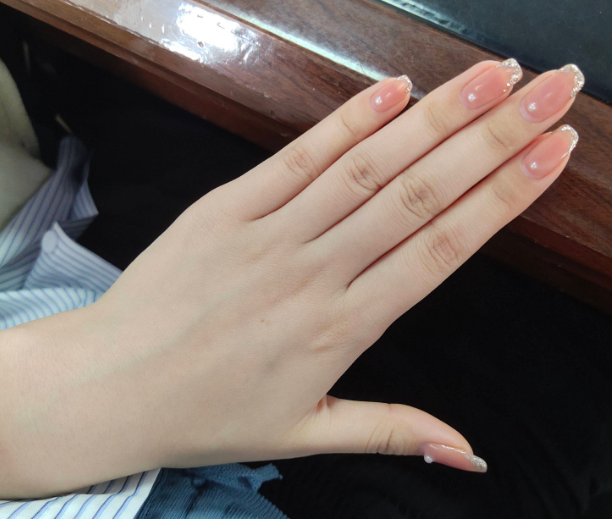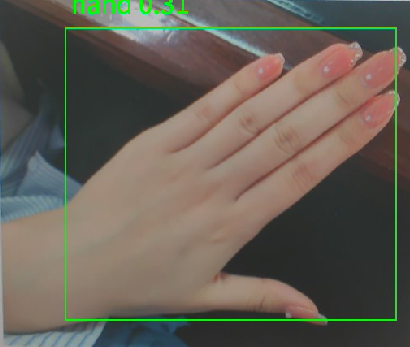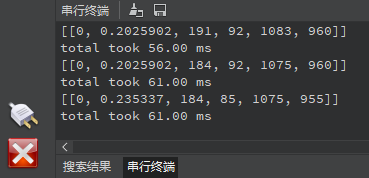手掌检测实验
前言
在上一章节中,我们已经学习了如何在CanMV下使用CanMV AI视觉开发框架和MicroPython编程方法实现跌倒检测的功能,本章将通过手掌检测实验,介绍如何使用CanMV AI视觉开发框架和MicroPython编程实现手掌检测并将检测的可信度绘制出来。在本实验中,我们首先采集摄像头捕获的图像,然后经过图像预处理、模型推理和输出处理结果等一系列步骤,系统会输出图像中的所有的手掌信息,完成手掌检测的功能。最后,将检测结果绘制并显示在显示器上。通过本章的学习,读者将掌握如何在CanMV下使用CanMV AI视觉开发框架和MicroPython编程方法实现手掌检测功能。
AI开发框架介绍
为了简化AI开发流程并降低AI开发难度,CanMV官方针对K230D专门搭建了AI开发框架,有关AI开发框架的介绍,请见CanMV AI开发框架
硬件设计
例程功能
- 获取摄像头输出的图像,然后将图像输入到CanMV K230D的AI模型进行推理。本实验使用了一个手掌检测模型,该模型用于检测图像中的手掌位置并输出其可信度。通过AI推理出图像中人的手掌的坐标,然后根据坐标在图像中绘制矩形框进行标注,并在矩形框的上方显示手掌检测的可信度。最后,将处理后的图像显示在LCD上。
硬件资源
- 本章实验内容主要讲解K230D的神经网络加速器KPU的使用,无需关注硬件资源。
原理图
- 本章实验内容主要讲解K230D的神经网络加速器KPU的使用,无需关注原理图。
实验代码
from libs.PipeLine import PipeLine, ScopedTiming
from libs.AIBase import AIBase
from libs.AI2D import Ai2d
import os
import ujson
from media.media import *
from media.sensor import *
from time import *
import nncase_runtime as nn
import ulab.numpy as np
import time
import utime
import image
import random
import gc
import sys
import aicube
# 自定义手掌检测类,继承自AIBase基类
class HandDetectionApp(AIBase):
def __init__(self, kmodel_path, model_input_size, labels, anchors, confidence_threshold=0.2, nms_threshold=0.5, nms_option=False, strides=[8,16,32], rgb888p_size=[224,224], display_size=[1920,1080], debug_mode=0):
super().__init__(kmodel_path, model_input_size, rgb888p_size, debug_mode) # 调用基类的构造函数,初始化模型文件路径、模型输入分辨率、RGB图像分辨率和调试模式
self.kmodel_path = kmodel_path # 模型文件路径
self.model_input_size = model_input_size # 模型输入分辨率
self.labels = labels # 模型输出的类别标签列表
self.anchors = anchors # 用于目标检测的锚点尺寸列表
self.strides = strides # 特征下采样倍数
self.confidence_threshold = confidence_threshold # 置信度阈值,用于过滤低置信度的检测结果
self.nms_threshold = nms_threshold # NMS(非极大值抑制)阈值,用于去除重叠的检测框
self.nms_option = nms_option # NMS选项,可能影响NMS的具体实现
self.rgb888p_size = [ALIGN_UP(rgb888p_size[0], 16), rgb888p_size[1]] # sensor给到AI的图像分辨率,对齐到最近的16的倍数
self.display_size = [ALIGN_UP(display_size[0], 16), display_size[1]] # 显示分辨率,对齐到最近的16的倍数
self.debug_mode = debug_mode # 调试模式,用于输出调试信息
self.ai2d = Ai2d(debug_mode) # 实例化Ai2d类,用于实现模型预处理
# 设置Ai2d的输入输出格式和类型,这里使用NCHW格式,数据类型为uint8
self.ai2d.set_ai2d_dtype(nn.ai2d_format.NCHW_FMT, nn.ai2d_format.NCHW_FMT, np.uint8, np.uint8)
# 配置预处理操作,这里使用了pad和resize
def config_preprocess(self, input_image_size=None):
with ScopedTiming("set preprocess config", self.debug_mode > 0): # 使用ScopedTiming装饰器来测量预处理配置的时间
# 初始化ai2d预处理配置,默认为sensor给到AI的尺寸,可以通过设置input_image_size自行修改输入尺寸
ai2d_input_size = input_image_size if input_image_size else self.rgb888p_size
# 计算padding参数并应用pad操作,以确保输入图像尺寸与模型输入尺寸匹配
top, bottom, left, right = self.get_padding_param()
self.ai2d.pad([0, 0, 0, 0, top, bottom, left, right], 0, [0, 0, 0])
# 使用双线性插值进行resize操作,调整图像尺寸以符合模型输入要求
self.ai2d.resize(nn.interp_method.tf_bilinear, nn.interp_mode.half_pixel)
# 构建预处理流程
self.ai2d.build([1,3,ai2d_input_size[1],ai2d_input_size[0]],[1,3,self.model_input_size[1],self.model_input_size[0]])
# 自定义当前任务的后处理,用于处理模型输出结果
def postprocess(self, results):
with ScopedTiming("postprocess", self.debug_mode > 0): # 使用ScopedTiming装饰器来测量后处理的时间
# 使用aicube库的函数进行后处理,得到最终的检测结果
dets = aicube.anchorbasedet_post_process(results[0], results[1], results[2], self.model_input_size, self.rgb888p_size, self.strides, len(self.labels), self.confidence_threshold, self.nms_threshold, self.anchors, self.nms_option)
return dets
# 绘制检测结果到屏幕上
def draw_result(self, pl, dets):
with ScopedTiming("display_draw", self.debug_mode > 0): # 使用ScopedTiming装饰器来测量绘制结果的时间
if dets: # 如果存在检测结果
pl.osd_img.clear() # 清除屏幕上的旧内容
for det_box in dets: # 遍历每个检测框
# 根据模型输出计算检测框的像素坐标,并调整大小以适应显示分辨率
x1, y1, x2, y2 = det_box[2], det_box[3], det_box[4], det_box[5]
w = float(x2 - x1) * self.display_size[0] // self.rgb888p_size[0]
h = float(y2 - y1) * self.display_size[1] // self.rgb888p_size[1]
x1 = int(x1 * self.display_size[0] // self.rgb888p_size[0])
y1 = int(y1 * self.display_size[1] // self.rgb888p_size[1])
x2 = int(x2 * self.display_size[0] // self.rgb888p_size[0])
y2 = int(y2 * self.display_size[1] // self.rgb888p_size[1])
# 过滤掉太小或者位置不合理的检测框
if (h < (0.1 * self.display_size[0])):
continue
if (w < (0.25 * self.display_size[0]) and ((x1 < (0.03 * self.display_size[0])) or (x2 > (0.97 * self.display_size[0])))):
continue
if (w < (0.15 * self.display_size[0]) and ((x1 < (0.01 * self.display_size[0])) or (x2 > (0.99 * self.display_size[0])))):
continue
# 绘制矩形框和类别标签
pl.osd_img.draw_rectangle(x1, y1, int(w), int(h), color=(255, 0, 255, 0), thickness=2)
pl.osd_img.draw_string_advanced(x1, y1-50,32, " " + self.labels[det_box[0]] + " " + str(round(det_box[1], 2)), color=(255, 0, 255, 0))
else:
pl.osd_img.clear() # 如果没有检测结果,清空屏幕
# 计算padding参数,确保输入图像尺寸与模型输入尺寸匹配
def get_padding_param(self):
# 根据目标宽度和高度计算比例因子
dst_w = self.model_input_size[0]
dst_h = self.model_input_size[1]
input_width = self.rgb888p_size[0]
input_high = self.rgb888p_size[1]
ratio_w = dst_w / input_width
ratio_h = dst_h / input_high
# 选择较小的比例因子,以确保图像内容完整
if ratio_w < ratio_h:
ratio = ratio_w
else:
ratio = ratio_h
# 计算新的宽度和高度
new_w = int(ratio * input_width)
new_h = int(ratio * input_high)
# 计算宽度和高度的差值,并确定padding的位置
dw = (dst_w - new_w) / 2
dh = (dst_h - new_h) / 2
top = int(round(dh - 0.1))
bottom = int(round(dh + 0.1))
left = int(round(dw - 0.1))
right = int(round(dw + 0.1))
return top, bottom, left, right
if __name__=="__main__":
# 显示模式,默认"lcd"
display_mode="lcd"
display_size=[640,480]
# 模型路径
kmodel_path="/sdcard/examples/kmodel/hand_det.kmodel"
# 其它参数设置
confidence_threshold = 0.2
nms_threshold = 0.5
rgb888p_size=[640,360]
labels = ["hand"]
anchors = [26,27, 53,52, 75,71, 80,99, 106,82, 99,134, 140,113, 161,172, 245,276] #anchor设置
# 初始化PipeLine
sensor = Sensor(width=1280, height=960) # 构建摄像头对象
pl = PipeLine(rgb888p_size=rgb888p_size, display_size=display_size, display_mode=display_mode)
pl.create(sensor=sensor) # 创建PipeLine实例
# 初始化自定义手掌检测实例
hand_det=HandDetectionApp(kmodel_path,model_input_size=[512,512],labels=labels,anchors=anchors,confidence_threshold=confidence_threshold,nms_threshold=nms_threshold,nms_option=False,strides=[8,16,32],rgb888p_size=rgb888p_size,display_size=display_size,debug_mode=0)
hand_det.config_preprocess()
try:
while True:
os.exitpoint() # 检查是否有退出信号
with ScopedTiming("total",1):
img=pl.get_frame() # 获取当前帧数据
res=hand_det.run(img) # 推理当前帧
# print(res) # 打印结果
hand_det.draw_result(pl,res) # 绘制结果到PipeLine的osd图像
pl.show_image() # 显示当前的绘制结果
gc.collect() # 垃圾回收
except Exception as e:
sys.print_exception(e)
finally:
hand_det.deinit() # 反初始化
pl.destroy() # 销毁PipeLine实例
可以看到一开始是先定义显示模式、图像大小、模型相关的一些变量。
接着是通过初始化PipeLine,这里主要初始化sensor和display模块,配置摄像头输出两路不同的格式和大小的图像,以及设置显示模式,完成创建PipeLine实例。
然后调用自定义HandDetectionApp类构建人体检测任务类,HandDetectionApp类会对AIBase接口的初始化以及使用Ai2D接口的方法定义手掌检测模型输入图像的预处理方法。
最后在一个循环中不断地获取摄像头输出的RGBP888格式的图像帧,然后将图像输入到手掌检测模型进行推理,然后将推理结果通过print打印,同时通过结果信息将手掌信息通过矩形框绘制到图像上,并在LCD上显示图像。
运行验证
实验原图如下所示:

将K230D BOX开发板连接CanMV IDE,点击CanMV IDE上的“开始(运行脚本)”按钮后,将摄像头对准手掌,让其采集到手掌图像,随后便能在LCD上看到摄像头输出的�图像,图像中的手掌区域用矩形框标注并在矩形框上方显示手掌的可信度,如下图所示:

点击左下角“串行终端”,可以看到“串行终端”窗口中输出了一系列信息,如下图所示:

可以看到,输出的数据格式和上一章实验相似,这里就不在详叙了,需要对结果数据进一步应用的请参考上一章内容。